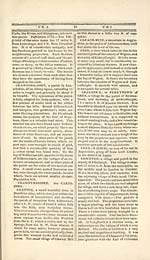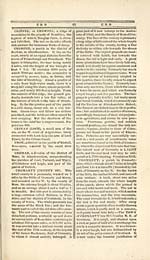Gazetteer of Scotland
(64) Page 62
Download files
Complete book:
Individual page:
Thumbnail gallery: Grid view | List view

C R I 62
to King James II. a powerful aad spirited
statesman in that turbulent age, and the
adviser of the bold but bloody deeds against
the too potent Douglas. During the life of
Crichton this castle was besieged, taken,
and levelled to the ground, by William
Earl of Douglas. It was afterwards rebuilt,
and part of this new work is uncommonly
elegant. Population 10S2.
CRICHUP, a rivulet in the parish of
Closeburn, Dumfries-shire. It takes its
rise from a moss, near the N. E. extremity
of the parish, and, not far from its source,
forms a beautiful cascade, by falling over a
precipice nearly 90 feet in height. Half a
mile below this, the water has hollowed
out for itself a strait passage through a hill
of red freestone, forming a very romantic
linn. This linn, from top to bottom, is a-
bout 110 feet, and, though 20 feet deep, is
bo close at the top, that one might easily
leap across it, if his imagination could be
abstracted from the tremendous abyss be-
low, and the noise of the falling water, in-
creased by the echoes from the surrounding
xocks. Sis miles below, the Crichup joins
its waters to the Nith.
CRIECH, a parish in the county of Fife,
extending in length about 5, and in breadth
about 2 miles. Its surface is nearly level,
and the soil sandy and thin ; but agricul-
ture is making rapid improvements.
Limestone is plenty at the distance of 10
miles. On a little eminence, near the
church, are the vestiges of a Roman camp,
■with two lines of circumvallation. There
is another of the same kind on a higher
hill, W. of the former. Not far from the
church is a castle which belonged to Car-
dinal Beaton, and where it is said, his emi-
nence kept a country seraglio! Popula-
tion 403.
CRIECH, an extensive parish in the
county of Sutherland. It stretches from
Dornoch on the E. coast to Assint on the
W. coast, at least 40 measured miles. The
length of the inhabited patt of the district
is reckoned about 21 miles, the breadth is
unequal, varying from 2 to 10 miles. — A-
bout one-thirtieth part of the district only
is cultivated, the rest being hilly, and co-
vered with moory ground. The arable soil
is light and thin, except at the E. end,
where there is a deep loam. There are
some meadows on the banks of the frith,
and the rivulets which run into it. The
seasons are generally early, and the crops
heavy. The two rivers Shin and Cassly
run through the parish, which is also wa-
tered on the S. by the Ockel. There are
also several lakes abounding with trout, of
which the largest are ca^ed I.och MigdoJ
and Loch Elst. A ridge of hills runs paral-
lel to the frith, the highest of which, in
the western extremity, is called Beinmore
Assint. There is a great deal of natural
wood, principally oak and birch ; and there
are several plantations of fir. The great
quantity of moss with which this district a-
bounds furnishes plenty of fuel. A vast
number of sheep and black cattle are rear-
ed on the heathy grounds. Near the church
is an obelisk, S feet high, and 4 broad, said
to have been erected in memory of a Danish
chief interred here. On the top of tbie
Dun of Criech is a fortification, erected a-
bout the beginning of the 12th century by
an ancestor of Ross.
CRIEFF, a parish of Perthshire, in the
district of Strathearne. The parish is na-
turally dividedinto Highland and Lowland,
of which the latter division is completely
surrounded by rivers. The Pow, the Ma-
derty, the Turrot, and Earne, all abound
with trout and salmon. The Highland di-
vision abounds with all sorts of game. The
soil is mostly light and gravelly ; in the vi-
cinity of the town it is loam. The parish
is well cultivated, and the greater part
inclosed. There is a good bridge over the
Earne at the town j at the other end of
which a thriving village, Bridgend, has
been lately built.— Population of the town
and parish 5530.— The TOWN of CRIEFF
lies 18 miles W. from Perth, and 22 N.
from Stirling. It is built on a risingground,
half a mile N. from the Earne, and near
the foot of the Grampians. It has a fine
southern exposure, and a delightful pros-
pect of hills, woods, vallies, and rivers, to
the W. Criert'is the second town in Perth-
shire, and is much resorted to in the sum-
mer months for its healthy situation. It
has a tolbooth, with a decent spire ; it has
also a large and elegant assembly-room,
which is sometimes honoured with the pre-
sence of the nobility and gentry of Perth-
shire. Although it has no regular govern-
ment, the different trades have erected
themselves into corporations for the sup-
port of decayed members and widows. The
chief manufacture carried on is making
Silesias, and weaving cotton goods for the
Glasgow manufacturers; there are about
400 weavers' looms in the place. The town
has greatly increased of late ; a number of
new houses have been built on the S. and
W. sides of the town ; and two paper-mills
have been lately erected. It contained, in
1811, nearly 3000 inhabitants.
to King James II. a powerful aad spirited
statesman in that turbulent age, and the
adviser of the bold but bloody deeds against
the too potent Douglas. During the life of
Crichton this castle was besieged, taken,
and levelled to the ground, by William
Earl of Douglas. It was afterwards rebuilt,
and part of this new work is uncommonly
elegant. Population 10S2.
CRICHUP, a rivulet in the parish of
Closeburn, Dumfries-shire. It takes its
rise from a moss, near the N. E. extremity
of the parish, and, not far from its source,
forms a beautiful cascade, by falling over a
precipice nearly 90 feet in height. Half a
mile below this, the water has hollowed
out for itself a strait passage through a hill
of red freestone, forming a very romantic
linn. This linn, from top to bottom, is a-
bout 110 feet, and, though 20 feet deep, is
bo close at the top, that one might easily
leap across it, if his imagination could be
abstracted from the tremendous abyss be-
low, and the noise of the falling water, in-
creased by the echoes from the surrounding
xocks. Sis miles below, the Crichup joins
its waters to the Nith.
CRIECH, a parish in the county of Fife,
extending in length about 5, and in breadth
about 2 miles. Its surface is nearly level,
and the soil sandy and thin ; but agricul-
ture is making rapid improvements.
Limestone is plenty at the distance of 10
miles. On a little eminence, near the
church, are the vestiges of a Roman camp,
■with two lines of circumvallation. There
is another of the same kind on a higher
hill, W. of the former. Not far from the
church is a castle which belonged to Car-
dinal Beaton, and where it is said, his emi-
nence kept a country seraglio! Popula-
tion 403.
CRIECH, an extensive parish in the
county of Sutherland. It stretches from
Dornoch on the E. coast to Assint on the
W. coast, at least 40 measured miles. The
length of the inhabited patt of the district
is reckoned about 21 miles, the breadth is
unequal, varying from 2 to 10 miles. — A-
bout one-thirtieth part of the district only
is cultivated, the rest being hilly, and co-
vered with moory ground. The arable soil
is light and thin, except at the E. end,
where there is a deep loam. There are
some meadows on the banks of the frith,
and the rivulets which run into it. The
seasons are generally early, and the crops
heavy. The two rivers Shin and Cassly
run through the parish, which is also wa-
tered on the S. by the Ockel. There are
also several lakes abounding with trout, of
which the largest are ca^ed I.och MigdoJ
and Loch Elst. A ridge of hills runs paral-
lel to the frith, the highest of which, in
the western extremity, is called Beinmore
Assint. There is a great deal of natural
wood, principally oak and birch ; and there
are several plantations of fir. The great
quantity of moss with which this district a-
bounds furnishes plenty of fuel. A vast
number of sheep and black cattle are rear-
ed on the heathy grounds. Near the church
is an obelisk, S feet high, and 4 broad, said
to have been erected in memory of a Danish
chief interred here. On the top of tbie
Dun of Criech is a fortification, erected a-
bout the beginning of the 12th century by
an ancestor of Ross.
CRIEFF, a parish of Perthshire, in the
district of Strathearne. The parish is na-
turally dividedinto Highland and Lowland,
of which the latter division is completely
surrounded by rivers. The Pow, the Ma-
derty, the Turrot, and Earne, all abound
with trout and salmon. The Highland di-
vision abounds with all sorts of game. The
soil is mostly light and gravelly ; in the vi-
cinity of the town it is loam. The parish
is well cultivated, and the greater part
inclosed. There is a good bridge over the
Earne at the town j at the other end of
which a thriving village, Bridgend, has
been lately built.— Population of the town
and parish 5530.— The TOWN of CRIEFF
lies 18 miles W. from Perth, and 22 N.
from Stirling. It is built on a risingground,
half a mile N. from the Earne, and near
the foot of the Grampians. It has a fine
southern exposure, and a delightful pros-
pect of hills, woods, vallies, and rivers, to
the W. Criert'is the second town in Perth-
shire, and is much resorted to in the sum-
mer months for its healthy situation. It
has a tolbooth, with a decent spire ; it has
also a large and elegant assembly-room,
which is sometimes honoured with the pre-
sence of the nobility and gentry of Perth-
shire. Although it has no regular govern-
ment, the different trades have erected
themselves into corporations for the sup-
port of decayed members and widows. The
chief manufacture carried on is making
Silesias, and weaving cotton goods for the
Glasgow manufacturers; there are about
400 weavers' looms in the place. The town
has greatly increased of late ; a number of
new houses have been built on the S. and
W. sides of the town ; and two paper-mills
have been lately erected. It contained, in
1811, nearly 3000 inhabitants.
Set display mode to: Large image | Transcription
Images and transcriptions on this page, including medium image downloads, may be used under the Creative Commons Attribution 4.0 International Licence unless otherwise stated. ![]()
| Gazetteers of Scotland, 1803-1901 > Gazetteer of Scotland > (64) Page 62 |
|---|
| Permanent URL | https://digital.nls.uk/97422462 |
|---|

